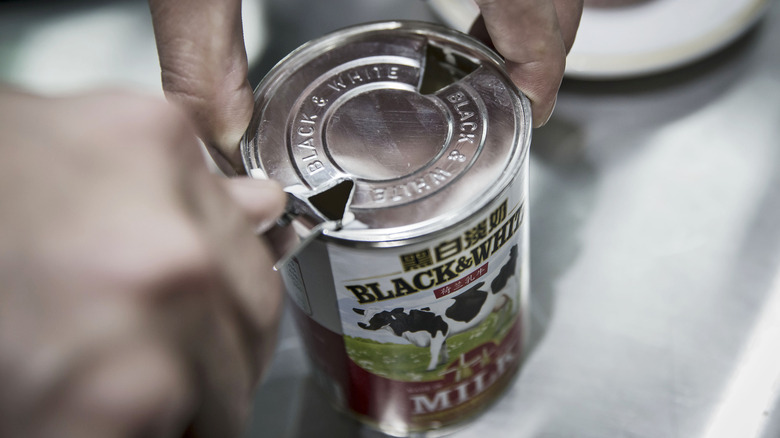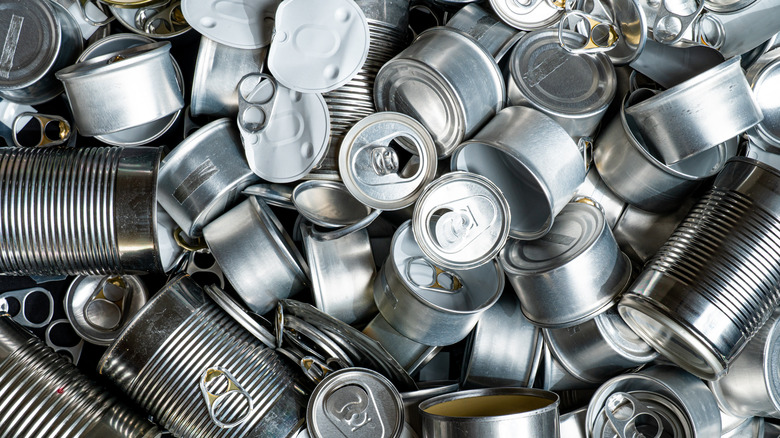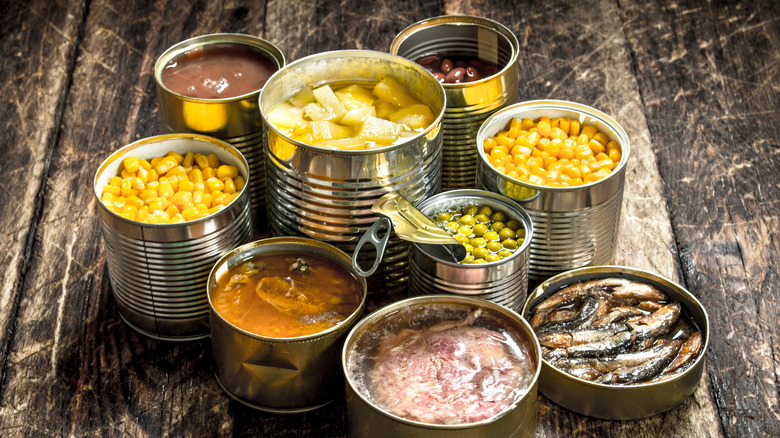Why It Took 50 Years After Inventing The Can To Invent The Can Opener
We'd all like to have consistent access to fresh fruits and vegetables whenever we need them. But for many, canned products work just as well and cost considerably less. That option didn't always exist, however, and even once it did, it wasn't exactly easy to use. In the early days of canned food's invention, can openers didn't exist yet — so people often opened their food with a chisel and hammer (via Vice).
That seems a lot riskier than the variety of methods available to us today, from peel-top cans to electronic can openers that do the work for you. But inventing those different methods took a lot of time, even after canned food was available on the market. In fact, it took about 50 years after the first canned food for someone to invent a separate can-opening device (via Smithsonian Magazine). So where did the invention come from, and why did it take so long?
Food and the military
Canned food has a lot of benefits. It's cheaper than some fresh produce, and you can find fruits or vegetables that would otherwise be out of season. But the reason they were created in the first place is a lot simpler. Soldiers needed the food to be preserved so that it would last longer while it was transported to them (via Smithsonian Magazine).
Napoleon Bonaparte was the first to raise this concern, according to Smithsonian Magazine, and offered a cash reward to anyone who could solve the problem of rotten food at army encampments. A solution came about in the early 1800s from scientist Nicolas Appert, but even that didn't result in the basic canned food we know today. The earliest example of preserved food was actually food stored in glass jars with lids, according to Smithsonian Magazine.
That method is still popular today, which is why Mason jars are widely available. Metal cans weren't far behind though; an inventor patented a metal can design later that same year.
Developing the perfect metal can
The first tin can patent went to Peter Durand in 1810, according to Smithsonian Magazine. But the cans weren't anything like what we use today. Instead, they were made of iron with a tin interior, and they took much longer to make. Because of how thick and sturdy they were, something like the metal wheels we know today wouldn't work at all — it had to be done with a hammer and chisel to properly break through (via Vice).
That probably explains the gap between the invention of cans and a can opener. As cans improved, they got thinner. Manufacturers shifted to steel cans instead of the heavy iron they'd used before, and then inventors could start looking at easier and more practical ways to get to the food inside. That led to the eventual creation of the can opener as we know it today.
The man who made it happen
Canning food came from France, and tin cans came from England. But according to Connecticut History, the first can opener was invented in the United States. Connecticut resident Ezra Warner came up with the first design in 1858, having designed a pointed blade that could pierce the cans with a protective guard to stop it from ruining the food inside. After the first blade cut through the metal, the guard could be moved, and a second curved blade cut around the top of the can.
The design was popular with the U.S. military, as well as in grocery stores. But the process usually left the metal around the top of the can jagged, and it was an unwieldy method for opening the cans (via Vice). As a result, the design never fully took off with the public. More improvements were needed to make canned foods fully accessible for the average family.
What came next?
It would take another few decades for someone to come up with the common can opener we know today. According to ThoughtCo, inventor William Lyman — also from Connecticut — created the rolling wheel opener available today in 1870. At the time, the wheel just had a straight, sharp edge. It wouldn't be until 1925 that it was modified to include a serrated edge by the Star Can Company of San Francisco, according to ThoughtCo. The electric version would come along about six years later.
These can opener designs haven't changed too much since then. You can even find some of the older designs in antique stores or on Swiss Army knives, according to Family Tree Magazine, although they'll be harder to use. It would take another 20 or 30 years for any significant changes in can design to come around, and even those haven't managed to fully replace the standard can opener design — at least not yet.
Reinventing the lid
In the 1960s, a different method was proposed: a pop-tab that came attached to the can (via ThoughtCo). The pop-tab would let you open the can without a second device handy, and the edge left behind is smooth and safer than the jagged metal left by a serrated blade.
While the pop-tab is available sometimes, it's not exactly ubiquitous. According to Vice, pop-tab cans that can be opened with just your hands are more expensive and complicated to produce than the standard can. So while the public might like the idea and it can make things simpler in the kitchen, the money isn't on our side. Pop-tabs have their own issues as well. As Vice points out, they can break off of the can before it's open, leaving you searching your drawers for a can opener anyway.





